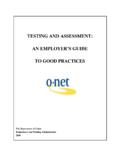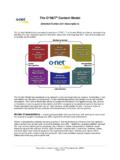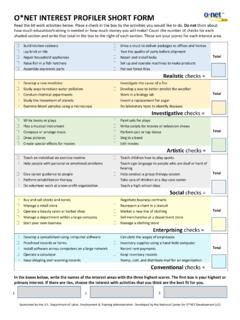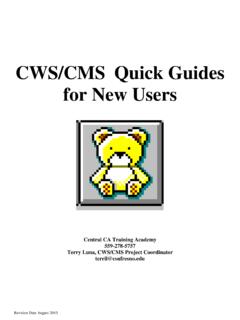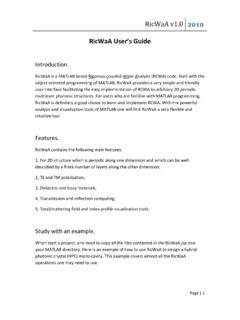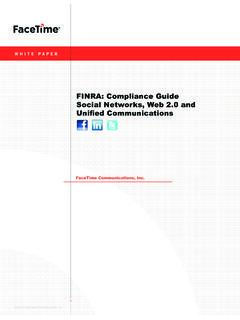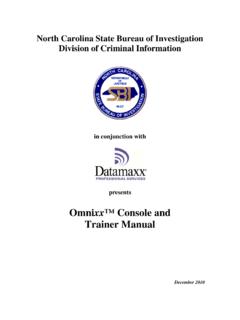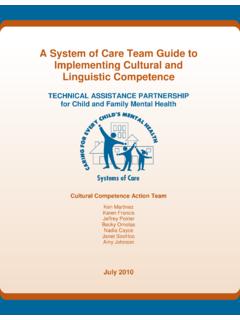Transcription of Occuaptional Value Profiles for New and Emerging ONET ...
1 Occupational Value Profiles for New and Emerging Occupations in the O*NET System: Summary James Rounds and Rong Su University of Illinois at Urbana-Champaign, Department of Educational Psychology and Psychology David Rivkin & Phil Lewis National Center for O*NET Development Prepared for Department of Labor Employment and Training Administration Office of Workforce Investment Division of Workforce System Support Washington, DC Submitted by The National Center for O*NET Development May 2012 National Center for O*NET Development, Post Office Box 27625, Raleigh, NC 27611 National Center for O*NET Development 1 The purpose of this report is to summarize the effort to populate work values information for 83 O*NET-SOC occupations recently included within the O*NET-SOC 2010 Taxonomy (O*NET-SOC 2010 ).
2 The Occupational Information Network (O*NET) is a comprehensive system for collecting, organizing, describing, and disseminating data on occupational characteristics and worker attributes. The Department of Labor (USDOL) developed the O*NET System as the replacement for the Dictionary of Occupational Titles ( Department of Labor, 1991). By providing information online in a searchable database, the O*NET Program allows for easier access to data on occupations at different levels of detail, thereby facilitating its utility for a variety of consumers. Businesses and human resources professionals can use O*NET products and tools for a variety of purposes, including the development of job descriptions, expanding the pool of quality candidates for open positions, aligning organizational development with workplace needs, and refining recruitment and training goals.
3 Job seekers can use O*NET information to identify jobs that fit with their interests, values, skills, and experience, explore growth career Profiles using the latest available labor market data, make effective career-related decisions to maximize earning potential and job satisfaction, and develop their understanding of what it takes to be successful in their field and in related occupations. The O*NET Program also provides an invaluable resource for researchers who study issues related to the workplace and labor market. O*NET data are organized around the Content Model, a framework for specifying the taxonomy of information describing the world of work presented within the O*NET database (see Peterson, Mumford, Borman, Jeanneret, & Fleishman, 1999). As part of the Content Model, Occupational Value Profiles (OVPs) were developed based on the Theory of Work Adjustment (Dawis & Lofquist, 1984) as a Value -based classification of work environments.
4 The OVPs provide an important link between the O*NET occupations and Value -based assessments that are often used in career counseling and other applied settings. The present summary focuses on the effort to generate work-related values information included in the Worker Characteristics domain of the Content Model ( , features of employment that O*NET users may Value or view as personally important). Work importance ( , work values) information within the O*NET System provides an important data set for career guidance and research that can be used with Work Importance Profiler ( Department of Labor, 2000b) or the Work Importance Locator ( Department of Labor, 2000a). Users can link their results from the Profiler or Locator directly to the work values information, allowing individuals to explore careers individually, with a career counselor, or in a group.
5 History The initial O*NET research on work values was completed in the late 1990s by McCloy, Waugh, Medsker, Wall, Rivkin, and Lewis (1999). This research project supported the use of the expert rating methodology for development of Profiles of Occupational Reinforcer Patterns and work values for the 1,122 occupations in the O*NET database. The Occupational Reinforcer Patterns and work values generated by the subject matter experts showed appreciable reliability, structural validity, and reasonable distribution across occupations. National Center for O*NET Development 2 In 2008, a new work values rating design was developed for the occupations in the O*NET database. The highlights of the Rounds, Armstrong, Liao, Lewis, and Rivkin (2008) research design for generating Occupational Value Profiles (OVPs) involved developing work Value definitions and rating scales.
6 Descriptions of the six work values from the Work Importance Profiler were reviewed and revised to fit the rating task. Rating scales developed by Rounds, Smith, Hubert, Lewis, and Rivkin (1999) were used to rate work values. The rating scales were anchored to indicate the extent (small, moderate, and great) to which an occupation reinforces the Value expressed in each of the six Value descriptions. The SMEs were instructed to ask themselves, to what extent does this occupation satisfy this work Value ? For example, the scales used for the work Value of Autonomy: Autonomy Occupations that satisfy this work Value allow employees to develop their own ideas and make their own decisions, and also place responsibility on the employee. Corresponding needs are Creativity, Responsibility and Autonomy.
7 Rate the occupation on the work Value of AUTONOMY using the following seven-point scale. Ask yourself, To what extent does this occupation satisfy this work Value ? Very Small Extent Moderate Extent Great Extent 1 2 3 4 5 6 7 These work Value definitions and scales were used by occupational analysts to rate the O*NET database of 909 occupations, yielding a second generation of work Value Profiles (Rounds, et al., 2008). Present OVP Ratings The goal of the present project is to populate work values information for 83 O*NET-SOC occupations identified after the 2008 project described above.
8 These occupations are either new and Emerging occupations or occupations identified within the 2010 Standard Occupational Classification (SOC; Office of Management and Budget, 2010 ). The present project followed the methodology used by Rounds et al. (2008) to generate occupational work values. The research design for generating OVPs involved obtaining work Value score Profiles from a Subject Matter Expert (SME) study in which work Value scores were derived from expert judgments of occupational analysts. The study was composed of three phases: a) initial development of materials for rating the OVPs for the occupations, b) training the SMEs to use the rating materials in a reliable and accurate manner, and c) the main rating study in which OVPs for the 83 O*NET occupations were created.
9 See Appendix A and the O*NET Resource Center (insert Database link) for these occupations and their OVPs. To develop materials containing data associated with the target occupations, we selected the following O*NET information for each occupation: Title, Description, and Core Tasks. See Appendix B for examples of this information. The SMEs followed standardized procedures to review this information and make OVP ratings. In the next phase, raters were trained. For training purposes, occupations were selected that have not changed through the two major National Center for O*NET Development 3 occupational classification revisions (that is, occupations that have not been rolled up, or had a title or definition change). The project leader (James Rounds) and two Counseling Psychology graduate students that were involved in the Rounds et al.
10 (2008) OVP project rated a representative sample of occupations. The resulting OVPs were compared to the occupational Value Profiles generated by McCloy et al. (1999) and Rounds et al. (2008). In general, consensus was found across the three sets of OVPs. Inter-rater reliabilities for 120 training occupations were calculated to evaluate consistency among raters. We trained raters until reliabilities were greater than .80. In the final phase, the raters rated the 83 occupations. To assess the degree of inter-rater agreement, rater-by-rater cross-classification tables were constructed using the obtained raw ratings. For each pair of raters, a separate cross-classification table was constructed for each of the work Value categories. Goodman-Kruskal s Gamma (Goodman & Kruskal, 1954) was computed to assess inter-rater agreement.



